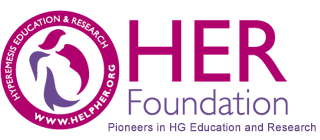Letter
A letter from Dr. Marlena Fejzo, Harvard PhD, HG research scientist and HG survivor ....
Dear HG moms, families and friends,
My name is Marlena Fejzo and I am a scientific researcher/advisor and board member for the HER Foundation. I have a Ph.D. in medicine from Harvard University and am a faculty researcher with joint appointments at UCLA and USC. I have published papers on my genetic studies of many diseases of women including ovarian cancer, breast cancer, and multiple sclerosis and I discovered the first gene involved in uterine fibroids. I am also a mother of a 15-year old boy and 10 year old twin girls. In 1999 I lost a baby in the 2nd trimester due to HG. HG has changed my life - my family and my career.
HG is the 2nd leading indicator for hospitalization during pregnancy and yet very little research dollars are spent on it. Drug companies and universities virtually stopped supporting HG research or drug development after babies were born without their limbs when thalidomide was given to treat HG in the 1950s. With the strong partnership with the HER Foundation since 2007, we have begun to scratch the surface in answering important questions about HG. Due primarily to recruitment on www.helpher.org, we have enrolled over 1500 participants and have been able to publish 13 scientific articles from surveys on the HelpHER.org website, answering questions covering the psychosocial burden, therapeutic termination, treatment trends, a link between HG and ovarian hyperstimulation syndrome, familial aggregation, recurrence risk, post-traumatic stress, risk factors, treatments, and outcomes associated with both prolonged HG and extreme weight loss, change in partner and recurrence risk, and long term outcome of exposed offspring. Our next publication will focus on identifying measures associated with preterm birth such as severity of disease, time of first symptoms, time of first treatment, and treatment modality.
To date, the most significant risk factor associated with HG is having a sibling with HG, which constitutes a greater than 17-fold increased risk and suggests a strong genetic component to the disease. Due in part to financial support from the HER Foundation, we have collected DNA from 775 women with HG and 546 friend controls, in addition to DNA from over 30 families with 2 or more affected individuals. With the help of HER donations, these samples will be used for a genome-wide association study and an exome sequencing study at UCLA. This study will provide the foundation necessary to achieve the long-term goal of unlocking the biological mechanisms behind HG. Ultimately, this study will drive development of new and better therapies that target the cause of the disease, not just the symptoms, and limit the associated maternal and fetal suffering.
Approximately 20,000 babies are lost annually in the US from HG pregnancies. This research will be a first step in putting an end to this devastatingly high number of fetal deaths. It will enable us to prevent this poorly understood disease that effects too many of us: families, initially thrilled to be pregnant, whose lives are suddenly turned upside down, suddenly forced to take medications designed for cancer patients, some who have to make the hardest decision of all, to abort in order to survive, and others still, like myself, who don't abort but whose babies die anyway.
Please allow me to summarize briefly what HG is by explaining what happened to me in 1999. Just 5 weeks into my pregnancy, I was hospitalized with severe dehydration. My doctor sent me home with a bottle of pills and the first and last picture of my healthy baby. I spent the next two months day and night fighting off nausea and vomiting so extreme I couldn't eat or drink anything – not even a sip of water. I had numerous other symptoms as well, but the overwhelming problem was the constant vomiting. I became so weak from losing an excessive amount of weight and was so nauseated that I was not able to leave my bed, even to use the bathroom. I could not even turn to my side, let alone sit upright without vomiting. My doctor had Zofran, a medicine that is used to prevent vomiting during chemotherapy, pumped into my leg and later moved to IV in my arm when there wasn't any fat left in my thigh to absorb the drug. And later, after weeks and weeks of utter starvation, too weak to talk, having to use a buzzer to communicate the need for a bedpan or Zofran change, I was put on 7 different drugs at once as a last attempt to try to get me to be able to eat. Nothing worked. When my veins became too thin to retain an IV, they inserted a PICC line into my chest. Ultimately I started hemorrhaging, and, in a wheel chair, unable to walk or even sit upright, I listened as my doctor told me I looked like I had been through a war and that my 15 week old fetus was dead. HG was 10 unbearable weeks of constant suffering, horrifying for me, horrifying for my family, and deadly for my innocent, unborn child.
When I recovered, I was shocked to learn that there was so little scientific research on HG and there and then decided to devote my life to studying HG. With your help, I hope that we can find a proper treatment or a cure for this terrible disease. The cost of my HG pregnancy that ended in fetal death was over 200,000 dollars. How many more babies have to die before we realize that an investment in HG research will save money and lives?
Sincerely,
Marlena Schoenberg Fejzo, Ph.D.
Updated on: Sep. 15, 2022




 The Chronicles of Nausea
The Chronicles of Nausea Beyond Morning Sickness
Beyond Morning Sickness